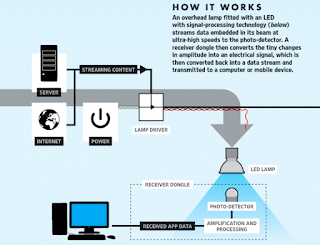Lifi: The New WireLess Tech
An Estonian startup called Velmenni used a Li-Fi-enabled
lightbulb to transmit data at speeds as fast as 1 gigabit per second (Gbps),
which is about 100 times faster than current Wi-Fi technology, meaning a
high-definition film could be downloaded within seconds. The real-world test is
the first to be carried out, but laboratory tests have shown theoretical speeds
of 224 Gbps.
Who Invented Li-Fi?
The term was coined by German physicist Harald Haas during a
TED Talk when he outlined the idea of using lightbulbs as wireless routers.
That address was delivered four years ago, and many people speculated that,
like a lot of apparent revolutionary breakthroughs, Li-Fi would go the way of
other "next big things" and not come to fruition. A year after his
TED Talk, though, Haas, a professor of mobile communications at the University
of Edinburgh, created pureLiFi with a group of people who had been researching
the technology since 2008. The company has claimed to be the "recognized
leaders in Li-Fi technology" and has already produced two products.
HowDoes Li-Fi Work?
This is how pureLiFi describes the operation of its
technology:
When a constant
current is applied to an LED [light-emitting-diode] lightbulb, a constant
stream of photons are emitted from the bulb which is observed as visible light.
If the current is varied slowly, the output intensity of the light dims up and
down. Because LED bulbs are semiconductor devices, the current, and hence the
optical output, can be modulated at extremely high speeds which can be detected
by a photodetector device and converted back to electrical current. The
intensity modulation is imperceptible to the human eye, and thus communication
is just as seamless as RF [radio frequency technology]. Using this technique,
high-speed information can be transmitted from an LED lightbulb.
Will It Work With Any Lightbulb?
Haas said during his Ted Talk in 2011 that the current
infrastructure would allow every single LED lightbulb to be transformed into an
ultrafast wireless router. "All we need to do is fit a small microchip to
every potential illumination device and this would then combine two basic functionalities:
illumination and wireless data transmission," Haas said. "In the
future, we will not only have 14 billion lightbulbs, we may have 14 billion
Li-Fis deployed worldwide for a cleaner, greener and even brighter
future."
Is There Any Downside?
Because Li-Fi technology uses visible light as its means of
communication, it won't work through walls. This means that to have a Li-Fi
network throughout your house, you will need these lightbulbs in every room
(and maybe even the fridge) to have seamless connectivity.
Another major issue is that Li-Fi does not work outdoors,
meaning that public Li-Fi will not be able to replace public Wi-Fi networks any
time soon. While Li-Fi's employment in direct sunlight won't be possible,
pureLiFi said that through the use of filters the technology can be used
indoors even when sunlight is present.
When Will Li-Fi Lightbulbs Be Available?
Speaking to International Business Times UK this week,
Deepak Solanki, CEO of Velmenni, said the technology could reach consumers in
three to four years. "We are doing a few pilot projects within different
industries where we can utilize the VLC technology," Solanki said.
"Currently, we have designed a smart-lighting solution for an industrial
environment where the data communication is done through light. We are also
doing a pilot project with a private client where we are setting up a Li-Fi
network to access the Internet in their office space."
So Can I Throw Out My Wi-Fi Router?
Probably best not to do it yet. It is going to take some
time for Li-Fi-enabled devices to come to market, and, when they do, it is
likely they will work in parallel with Wi-Fi networks to deliver a more rounded
and seamless experience. One possible situation domestically is the employment
of a Wi-Fi network for general use and a couple of Li-Fi hotspots for
high-speed uses.



Comments
Post a Comment